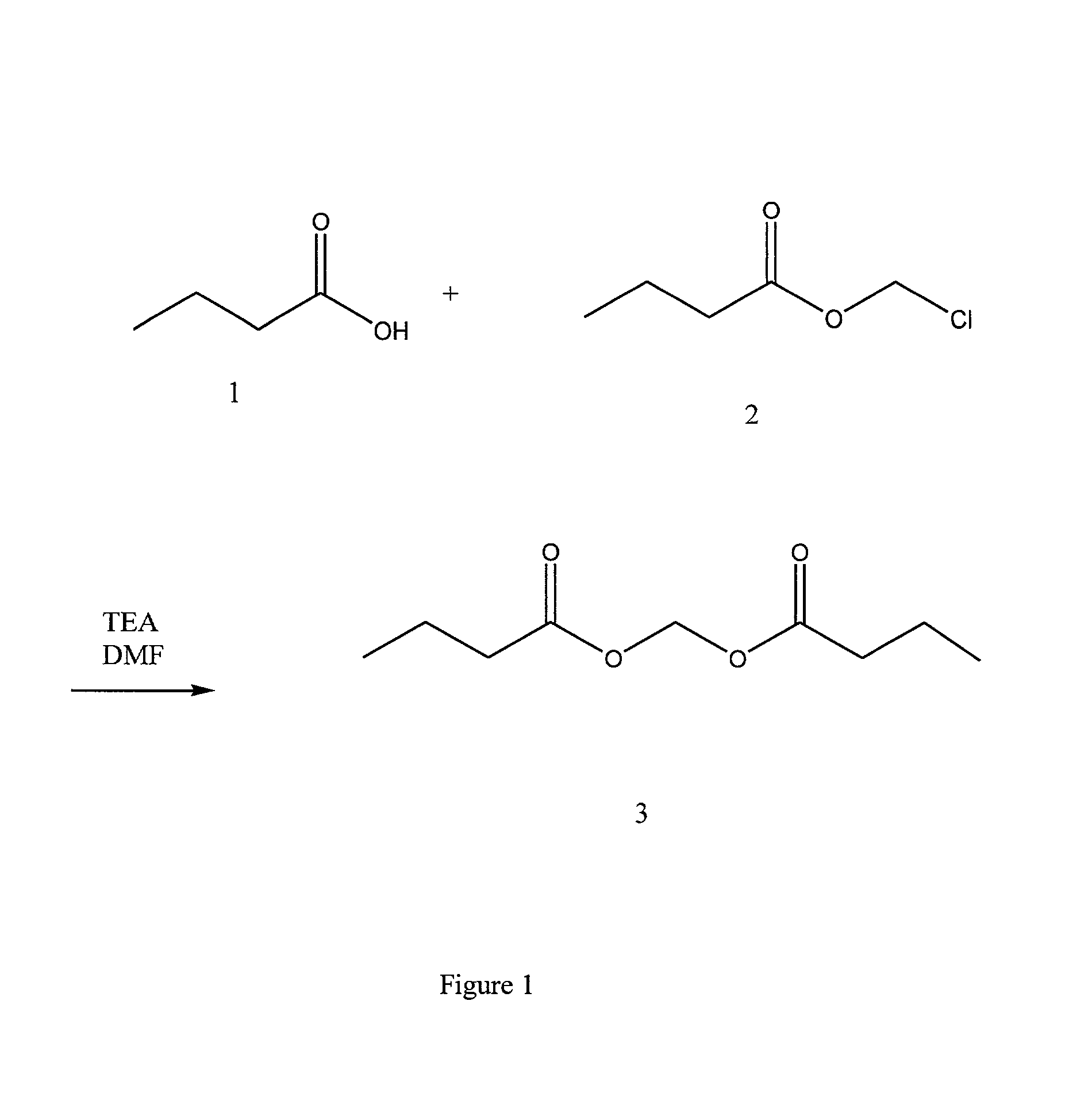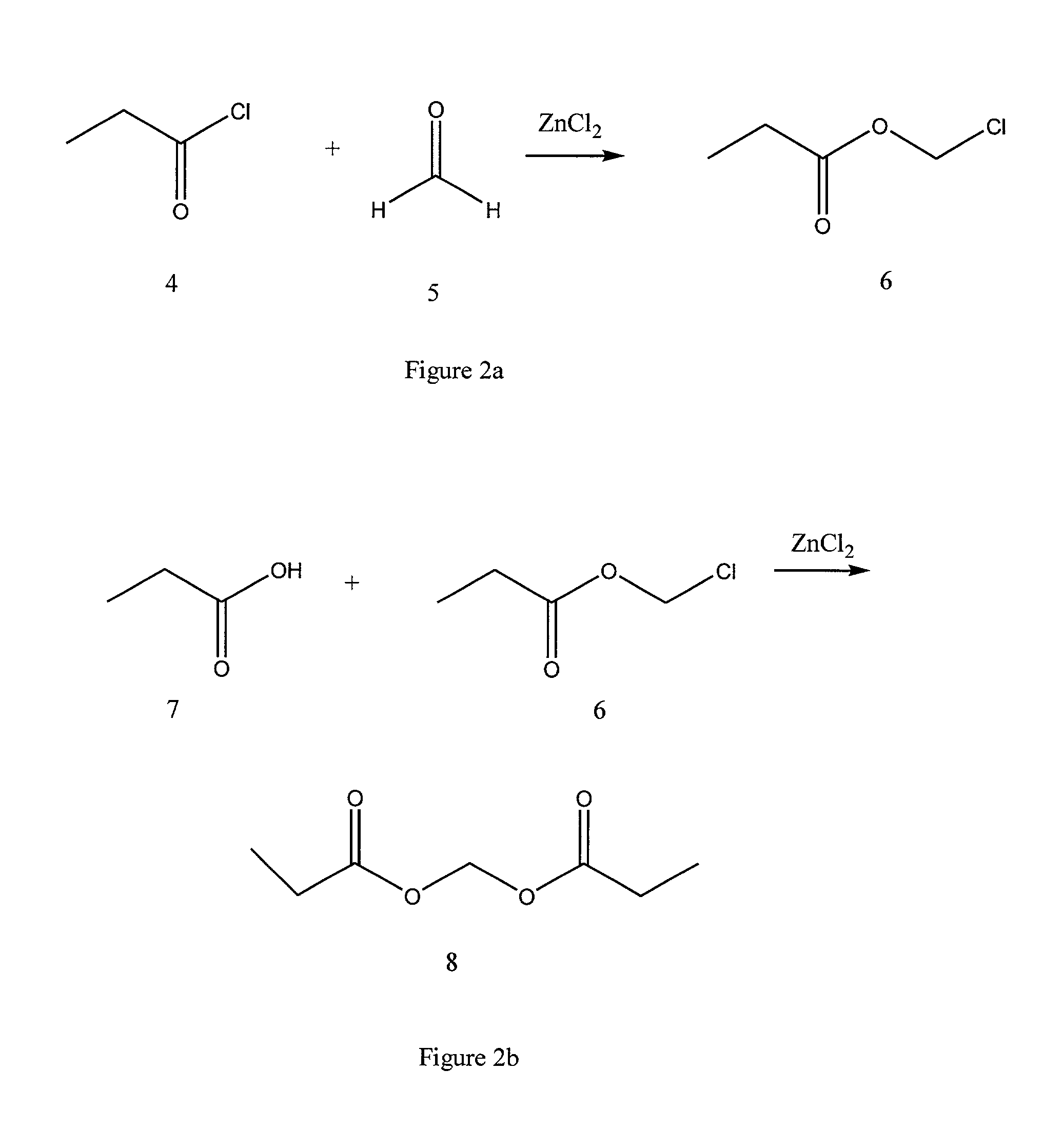Novel methods for using alkanoyloxymethyl esters
a technology of alkanoyloxymethyl esters and alkanoyloxymethyl esters, which is applied in the field of new methods for using alkanoyloxymethyl esters, can solve the problems of low potency of butyric acid and its salts, large doses to achieve even minimal therapeutic effects, and inability to detect and treat the effects of aqueous solution
- Summary
- Abstract
- Description
- Claims
- Application Information
AI Technical Summary
Problems solved by technology
Method used
Image
Examples
example 1
Preparation of Butyroyloxymethyl Butyrate 3
[0035] Reference numerals correspond with those of FIG. 1.
[0036] A solution of 137.6 g of butyric acid 1 and 193.8 g of chloromethyl butyrate 2 in 550 mL of anhydous DMF in a 4-necked 2-L round bottom flask was cooled to about 12.degree. C. and the cooling bath was removed. To this solution was added dropwise 250 mL of TEA under a nitrogen atmosphere over about 1.2 hours. The temperature of the reaction mixture reached 23.degree. C. upon completion of addition. The resulting reaction mixture was stirred at ambient temperature for 20 hours.
[0037] An aliquot was then removed from the reaction mixture. Water and ethyl acetate were added. The ethyl acetate layer was removed, washed with water, and dried. GC of the ethyl acetate layer showed unreacted chloromethyl butyrate (based on the GC retention time, 3.44 min. 16.8%) and the product 3 (6.11 min, 83.2%). An additional 12 mL of butyric acid and 20 mL of TEA were added and the resulting mixtur...
example 2
Preparation of Propionoyloxymethyl Propionate 8
[0040] Reference numerals correspond with those of FIG. 2.
[0041] Zinc chloride (4.1 g) was added portionwise to a solution of 1945.5 mL of propionyl chloride 4 and 672 g of paraformaldehyde 5 and the resulting solution was heated to reflux and monitored by NMR. The reaction was violently exothermic, heated up to 105.degree. C. and refluxed out the top of the reflux condenser before {fraction (1 / 2)} of the zinc chloride had been added. The reaction mixture cooled back to about 78.degree. C. and the rest of the zinc chloride was added. The mixture was heated at 78.degree. C. overnight. The reaction mixture was distilled at atmospheric pressure with a 20 cm Vigreaux column to separate chloromethyl propionate 6 from impurities.
[0042] Chloromethyl propionate 6 was then reacted with propionic acid 7 in the manner described in Example 1 for chloromethyl butyrate and butyric acid. The product 8 was the result.
[0043] A summary of the components ...
example 3
[0044] The compounds prepared according to Examples 1 and 2 were tested for anti-proliferation against PC-3 prostate cancer cells. Trichostatin, a potent HDAC inhibitor, was purchased from Sigma-Aldrich, Milwaukee, Wis., and was used as a reference compound.
[0045] The PC-3 cell line was maintained in RPMI supplemented with 10% fetal calf serum and antibiotics. The EDR assay was performed as described by Kern and Weisenthal in "Highly Specific Prediction of Antineoplastic Drug Resistance With An In Vitro Assay Using Suprapharmacologic Drug Exposures," J. Nat. Cancer Inst., 82:582-588 (1990); and Fruehauf and Bosanquet, "In vitro Determination of Drug Response: A Discussion of Clinical Applications," PPO Updates 7(12):1-16 (1993). Cells were suspended in 0.12% soft agar in complete medium and plated (2,000 cells per well, as determined by preliminary experiments) in different drug concentrations onto a 0.4% agarose underlayer in 24-well plates. Plating cells on agarose underlayers sup...
PUM
| Property | Measurement | Unit |
|---|---|---|
| Linear density | aaaaa | aaaaa |
| Volume | aaaaa | aaaaa |
| Volume | aaaaa | aaaaa |
Abstract
Description
Claims
Application Information
 Login to View More
Login to View More - R&D Engineer
- R&D Manager
- IP Professional
- Industry Leading Data Capabilities
- Powerful AI technology
- Patent DNA Extraction
Browse by: Latest US Patents, China's latest patents, Technical Efficacy Thesaurus, Application Domain, Technology Topic, Popular Technical Reports.
© 2024 PatSnap. All rights reserved.Legal|Privacy policy|Modern Slavery Act Transparency Statement|Sitemap|About US| Contact US: help@patsnap.com










